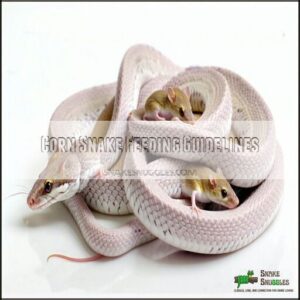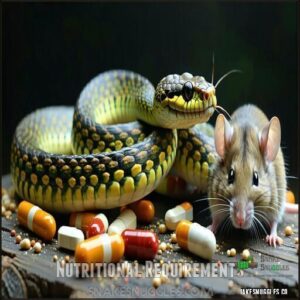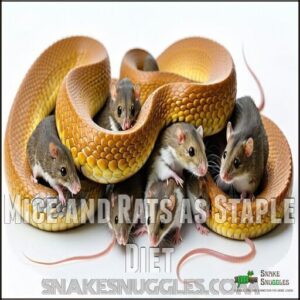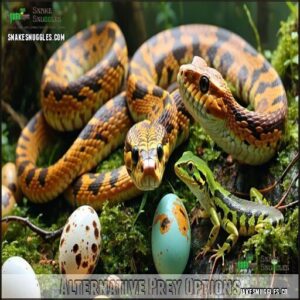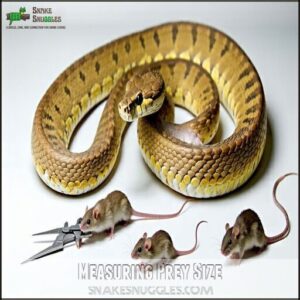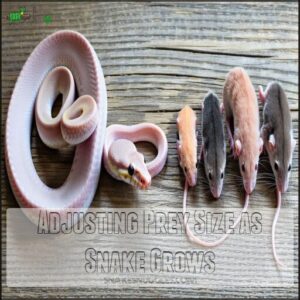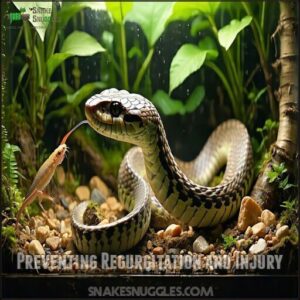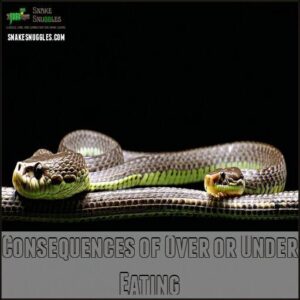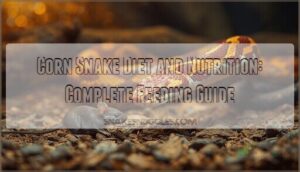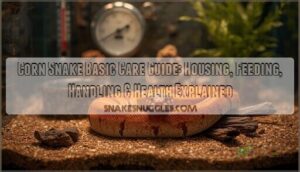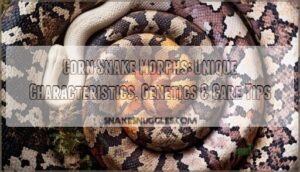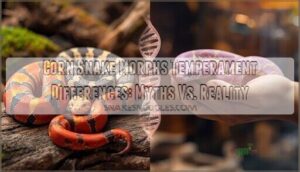This site is supported by our readers. We may earn a commission, at no cost to you, if you purchase through links.

Choose prey that’s no larger than 1.5 times the thickest part of your snake’s body.
For hatchlings, pinky mice are perfect, while juveniles can handle fuzzies or hoppers.
Adults typically graduate to adult mice or small rats, depending on their size.
Feeding prey that’s too big can lead to regurgitation, stress, or even injury, so it’s better to err on the smaller side.
Always monitor your snake’s body condition; a healthy snake should be neither bony nor overly plump.
Curious about adjusting prey size as your snake grows? Keep reading!
Table Of Contents
Key Takeaways
- Choose prey that’s 1-1.5 times your snake’s thickest body part to ensure safe swallowing and proper nutrition.
- Stick to frozen prey instead of live to avoid injuries and make feeding safer for your snake.
- Adjust prey size and feeding frequency as your snake grows to match its age and body condition.
- Watch for signs like regurgitation or weight changes to catch feeding issues early and keep your snake healthy.
Corn Snake Feeding Guidelines
Feeding your corn snake the right way keeps it healthy and thriving, no matter its age or size.
Proper feeding ensures your corn snake stays healthy and happy, growing strong at every stage of life.
By sticking to proper feeding schedules and choosing appropriately sized prey, you’ll avoid common issues like regurgitation or undernourishment, ensuring your snake remains healthy.
Feeding Frequency by Age
Feeding corn snakes depends on their age.
Hatchlings need meals every 5-7 days, while juveniles eat every 7-10 days.
Adults and seniors require less frequent feeding, around every 14-21 days.
Follow these tips:
- Stick to age-based schedules for a healthy corn snake diet.
- Adjust for seasonal changes, like winter slowdowns.
- Use appropriately sized prey for easy digestion to ensure a healthy corn snake diet.
Feeding Frequency by Size
In the context of corn snake feeding, size matters as much as age.
Hatchlings (8-20 inches) eat every 5-7 days, juveniles (20-45 inches) every 7-10 days, and adults over 35 inches every 14-21 days.
Senior snakes need meals every 10-14 days.
A snake feeding chart helps balance hatchling frequency, juvenile schedules, and adult intervals for a healthy corn snake diet.
Prey Size Recommendations
When choosing prey, size matters for your snake’s safety and health.
Follow these tips:
- Match prey to your snake’s ideal girth—1 to 1.5 times its widest body point.
- Keep prey weight under 10% of the snake’s body weight.
- Use sizing charts: hatchlings need pinky mouse size, juveniles prefer fuzzy or hopper mouse size, and adults require adult mouse size.
The key to successful feeding is to ensure that the prey is the right size for your snake, and by following these guidelines, you can help maintain its health.
Nutritional Requirements
Your corn snake’s diet needs to provide all the essential nutrients for healthy growth, shedding, and overall well-being.
Vitamins like A and D, along with proper calcium supplementation, play a key role in keeping your snake thriving, with vitamins being crucial for its health.
Vitamin a and Skin Health
Vitamin A is a powerhouse for your corn snake’s skin cell renewal and eye health.
It’s naturally found in mice liver, a staple in their diet. Deficiency signs include dull skin or vision issues, so stick to a balanced snake diet.
UVB lighting benefits calcium absorption, contributing to skin health.
Overdoing supplementation risks toxicity—always prioritize natural sources for ideal reptile nutrition and overall snake health.
Vitamin D and Bone Growth
Strong skeletal development in corn snakes hinges on proper calcium absorption, regulated by D3 importance.
UVB lighting boosts vitamin D levels, aiding calcium use and preventing metabolic bone disease.
Overdoing supplements can harm snake nutrition, so stick to natural vitamin D sources like mice liver.
Balanced snake feeding supplements guarantee healthy growth without risking a supplement overdose.
Calcium Supplementation
While vitamin D supports strong bones, calcium plays its part too.
Hatchlings rarely need calcium supplements since their rodent diet covers most needs.
Adults might benefit from monthly supplements with D3, especially breeding females.
Stick to a light dusting on prey—overdoing it can harm your snake.
Many owners purchase reptile calcium products for their snakes.
A balanced snake nutrition guide keeps feeding simple and your corn snake healthy.
Prey Types and Diet Variation
You’ve got plenty of options regarding feeding your corn snake, but mice and rats should always be the main course.
For a little variety, you can mix in quail eggs, lizards, or even specialty feeders like Reptilinks to keep things interesting and nutritious.
Mice and Rats as Staple Diet
Mice and rats are the backbone of a corn snake diet, offering complete rodent nutrition.
Stick to frozen vs. live prey for safety—frozen is easier and safer.
Choose the right rodent size based on your snake’s body width.
Feeding frequency depends on age and size, ensuring healthy growth.
Ensuring proper reptile dietary needs is vital for their well-being.
- Benefits of frozen prey: no injuries.
- Sourced from reputable suppliers.
- Easy storage in freezers.
- Balanced nutrition from whole prey.
- Safer, no live rodent bites.
Alternative Prey Options
Quail and eggs, lizards and frogs, and Reptilink options can spice up your corn snake’s menu.
Quail eggs or green anoles make great treats, while house geckos mimic natural prey.
Frogs are ideal for hatchlings, and reptilinks offer nutritional variety while reducing pickiness.
These alternatives keep meals interesting, ensuring your snake gets balanced nutrition without boredom.
Dietary Variety for Balanced Nutrition
If you’re sticking to just mice or rats, your snake might miss out on key nutrients.
Adding natural prey like quail, green anoles, or even Reptilinks boosts snake diet diversity.
Prey enrichment keeps feeding interesting while supporting snake nutrition.
Balance alternative meals with proper supplementation to avoid nutrient deficiencies, ensuring a varied snake feeding variety guarantees health and prevents pickiness, which is crucial for maintaining overall snake nutrition.
Feeding Techniques and Behavior
When feeding your corn snake, using tools like tweezers and creating a stress-free environment can make all the difference.
Understanding their natural behaviors, like preferring to eat in low light, helps guarantee mealtime goes smoothly, and using tools like tweezers can support this by making the feeding process easier and less stressful.
Presenting Food With Tweezers
Using tweezers for corn snake feeding keeps your hands safe and reduces bites, especially with excited eaters.
Snake feeding tongs guarantee proper prey presentation while maintaining hygiene practices.
This method mimics natural movement, encouraging your snake to strike confidently.
For specialized tools, consider browsing options for reptile feeding supplies.
Always choose tongs suited for reptile food size to handle appropriate prey size securely, following your snake food guide for safe handling.
Feeding in Darkness
Feeding in darkness aligns with your corn snake’s nocturnal behavior, reducing stress and encouraging natural instincts.
It mimics nighttime hunting, helping them feel secure while improving digestion.
This simple step in your snake feeding routine creates a hunting simulation that complements their natural patterns.
Stick to the snake food guide, ensuring appropriate prey size for a healthy corn snake diet.
Stimulating Appetite With Scent
If your corn snake feeding routine hits a snag, scent transfer can work wonders.
Rubbing anole or gecko skin on prey entices fussy eaters. Warm thawed prey to 37-39°C and wiggle it slightly to mimic live movement.
Remember to use safe prey handling to avoid potential injury. Avoid strong-smelling cleaners near the enclosure, as they interfere with scent detection.
These feeding techniques keep your snake curious and engaged, using live movement to stimulate their natural instincts.
Food Size and Snake Growth
Choosing the right prey size is key to your corn snake’s growth and overall health.
Feed prey that’s 1-1.5 times the snake’s mid-body width to guarantee safe swallowing and proper nutrition.
Measuring Prey Size
To measure prey size, compare the prey’s width to your snake’s mid-body girth—it should be 1-1.5 times wider.
Stick to the 10% weight ratio rule for safety. If unsure, frozen mice size charts help; fuzzy mouse size works for juveniles, while weaned rat size or small rat size fits adults.
For in-between stages, multiple prey items work well. Many keepers consult a frozen mice retailer to confirm proper sizing.
Adjusting Prey Size as Snake Grows
As your corn snake grows, adjust prey size to match its body width and growth stages.
Prey should be 1-1.5 times the snake’s mid-body girth and no more than 10% of its weight.
For instance, hatchlings thrive on frozen mice size like pinkies, while juveniles may need weaned rat sizes.
Proper prey weight supports feeding frequency and reduces regurgitation risk.
Preventing Regurgitation and Injury
To avoid regurgitation and injury during corn snake feeding, follow these tips:
- Stick to proper prey size—no larger than 1.5x the snake’s mid-body width.
- Maintain a stable temperature gradient in the enclosure.
- Avoid handling post-feeding for 48 hours.
- Reduce stress by ensuring hiding spots and minimal disturbances.
- Check enclosure safety to prevent accidents during digestion.
Consequences of Over or Under Eating
Feeding your corn snake too much or too little can lead to serious health problems, from obesity to malnutrition.
Understanding the signs of over- or under-eating helps you keep your snake healthy and thriving.
Signs of Overweight Snakes
If your snake looks like it’s swallowed a sausage casing, it’s time to check for snake obesity signs.
Skin fold assessment can reveal fat buildup, while rib cage palpation helps identify excess padding.
A poor weight-to-length ratio or reduced activity level also signals trouble.
Snake feeding weight management and portion control keep their health on track, ensuring a proper weight-to-length ratio is maintained is not necessary, instead:
Snake feeding weight management and portion control keep their health on track.
Signs of Underweight Snakes
Underweight snakes often show rib protrusion, spine visibility, and muscle loss, making their bodies appear angular.
You might notice lethargic behavior or poor shedding, both linked to malnutrition.
Snake feeding health signs like reduced appetite or irregular meals can indicate snake undereating causes.
Regularly check your snake’s weight—unexpected drops in snake body weight signal the need for dietary adjustments.
Managing Overeating and Undereating
Keeping your corn snake healthy means balancing portion size and activity.
Overeating can lead to obesity, while undereating might signal deeper snake feeding problems.
- Weight Monitoring: Weigh your snake regularly to track changes.
- Environmental Enrichment: Add climbing branches or hides to boost activity.
- Diet Adjustments: Consult a vet to tweak feeding schedules or prey types.
Health and Feeding Issues
Feeding issues can sneak up on you, leading to problems like regurgitation, illness, or appetite loss.
By keeping an eye on your snake’s health and environment, you’ll catch potential problems early and keep them thriving.
Monitoring for Regurgitation
Regurgitation happens when food is expelled before digestion, often from stress, improper temperatures, or oversized prey.
Watch for regurgitated prey within 48 hours of feeding.
To prevent snake feeding regurgitation issues, verify that prey size matches your corn snake’s mid-body girth and allow proper digestion periods.
If regurgitation persists, consult a vet for intervention and assess potential snake feeding health monitoring needs, focusing on the importance of proper prey size.
Identifying Signs of Illness
Spotting illness early is key to snake health.
Watch for these signs:
- Lethargy signs: Unusual inactivity or weakness.
- Abnormal shedding: Retained skin or incomplete sheds.
- Weight changes: Sudden loss or unexplained gain.
- Fecal abnormalities: Runny or discolored feces.
- Breathing issues: Wheezing or open-mouth breathing.
If symptoms persist, seek a vet consultation for proper care.
Addressing Reproductive Problems
If your corn snake skips meals during the breeding season, it might signal egg binding or infertility issues.
Watch for signs like weight loss or straining. Dystocia causes include poor body condition or structural problems.
Prolapse treatment and veterinary intervention can save your snake’s life. Balanced diets and proper snake feeding remedies support reproductive health and prevent complications in reptile care.
Providing proper environmental temperature control can also prevent these issues, ensuring a healthy environment for your snake and preventing dystocia and other breeding problems, which can be managed with proper veterinary intervention.
Frequently Asked Questions (FAQs)
Can corn snakes eat live prey safely?
Yes, but it’s risky.
Live prey can bite or injure your snake, causing stress or infection.
Stick to pre-killed, thawed prey—it’s safer and easier for both you and your scaly buddy.
How to transition corn snakes to frozen prey?
Start by thawing frozen prey thoroughly and warming it slightly to mimic live prey.
Use feeding tongs to wiggle it gently, simulating movement.
Patience is key—some snakes need time to adjust to the change.
What to do if prey is too large?
If the prey’s too large, switch to a smaller item or offer two smaller ones instead.
Oversized food can cause regurgitation or injury.
Prey should fit 1-5 times your snake’s body width.
Are there risks with feeding wild-caught prey?
Feeding wild-caught prey is like rolling dice with your snake’s health.
Wild prey often carries parasites, pesticides, or diseases that could harm your snake.
Stick to captive-bred feeders for safety and peace of mind.
How to handle picky eaters refusing food?
Try offering smaller prey or scenting it with anole or gecko skin to spark interest.
Feed at night, wiggle thawed prey with tongs, and reduce stress by ensuring proper enclosure conditions and minimal handling.
Conclusion
Feeding your corn snake is like solving a puzzle—each piece, including prey size, must fit perfectly.
By following this corn snake food size guide, you’ll guarantee your pet stays healthy and stress-free.
Remember, prey should never exceed 1.5 times your snake’s thickest part, and adjustments are key as they grow.
Monitor their weight and behavior to catch issues early.
With proper care and attention, your snake will thrive, making feeding time a smooth and rewarding experience.

